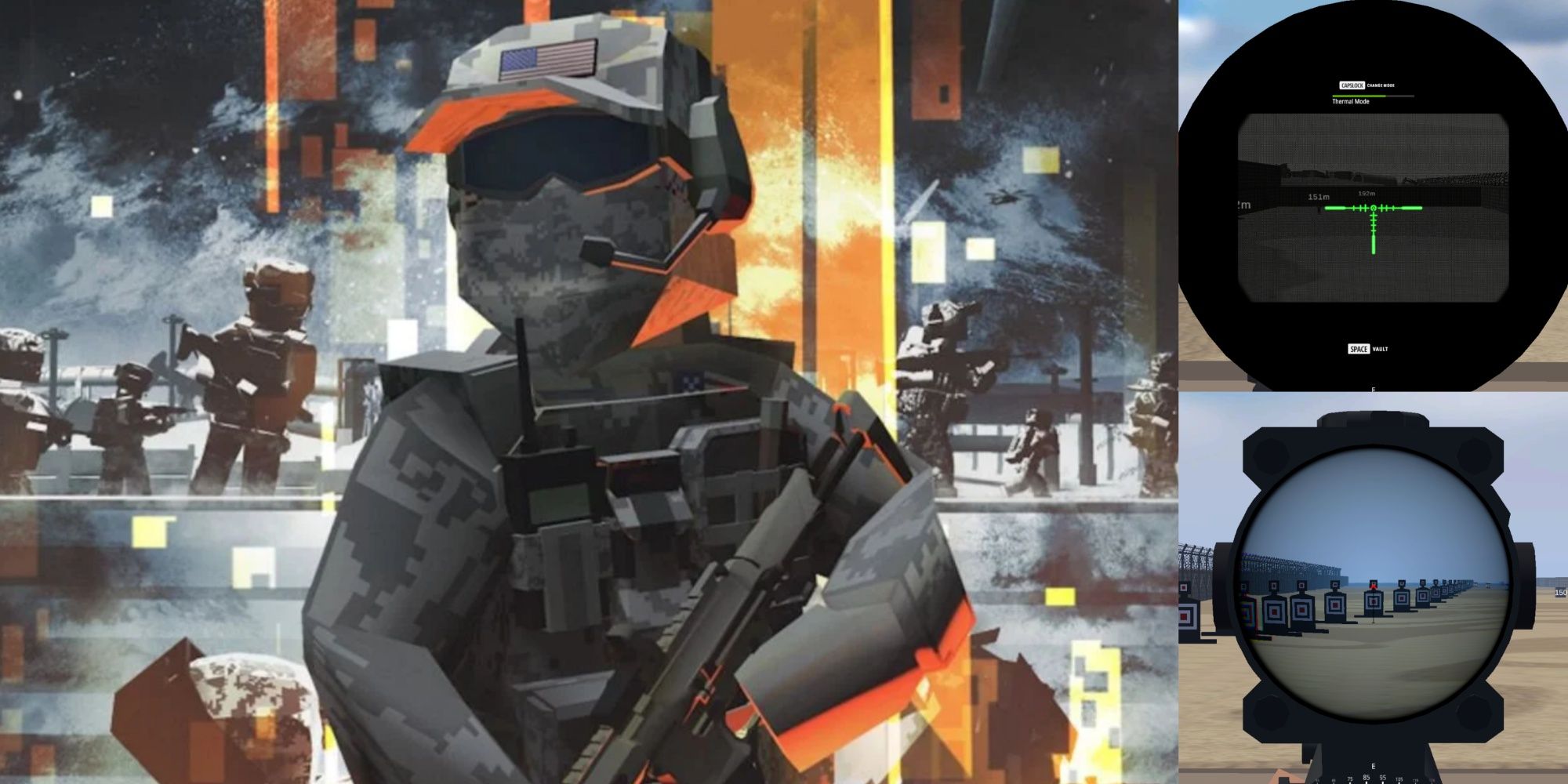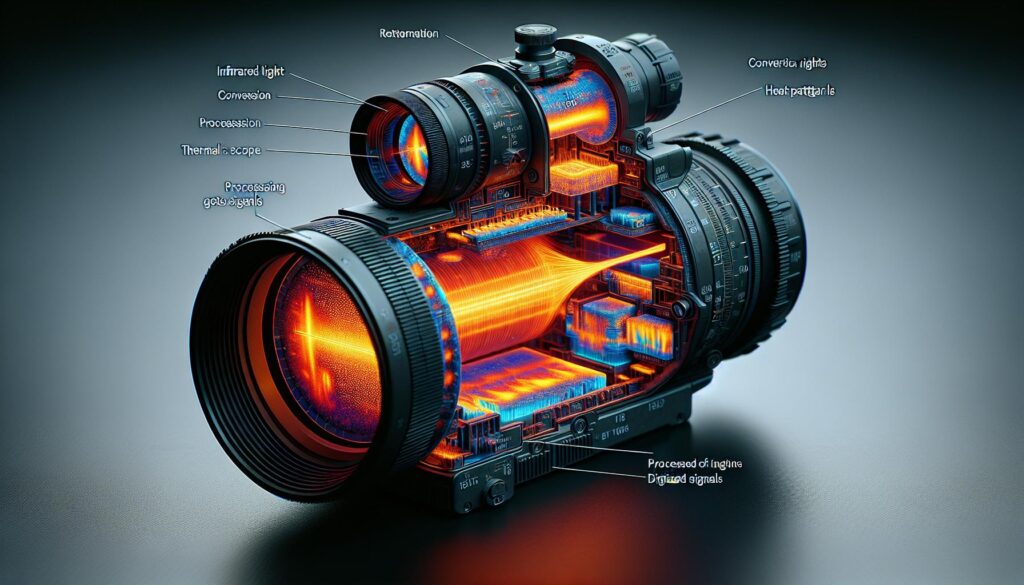A thermal scope works by detecting and visualizing infrared radiation emitted by objects and converting it into a visible image. A thermal scope is a device that uses advanced technology to detect and highlight the differences in temperature between objects.
It operates on the principle that all objects emit thermal radiation, or heat, as a result of their molecular activity. This radiation is invisible to the human eye, but a thermal scope can detect it and convert it into a visible image.
The scope contains a sensor that detects the infrared radiation and converts it into an electrical signal. This signal is then processed by the scope’s imaging system, which translates it into a visual display. The resulting image allows users to see objects even in complete darkness or through obscurants such as smoke or fog. Thermal scopes are commonly used in military, hunting, and surveillance applications, where their ability to detect heat signatures can provide crucial information.
Table of Contents
The Basics Of Thermal Imaging
A thermal scope works by converting heat into visible images, allowing users to see in the dark or detect hidden objects. This technology relies on the principle that all objects emit heat, even at lower levels that are not visible to the human eye.
The thermal scope uses a lens to capture the infrared radiation emitted by objects and converts it into an electronic signal. This signal is then processed by an electronic sensor, which assigns different colors or shades to represent variations in temperature.
The resulting image is displayed on the scope’s screen, allowing users to identify and locate objects based on their heat signatures. The components of a thermal scope include the lens, the sensor, and the display screen, all working together to provide a clear and accurate thermal image.
By understanding how thermal scopes work and their components, users can effectively utilize them for a variety of applications, such as hunting, surveillance, and search and rescue operations.
How Thermal Scopes Work: The Process Unveiled
Thermal scopes work by collecting thermal radiation through the lens, which plays a crucial role. The lens captures the heat emitted by objects and converts it into an electrical signal. This signal is then sent to the thermal detector, which identifies the differences in thermal energy and creates an image based on these variations.
The thermal detector plays a key function in picking up and interpreting the infrared wavelengths emitted by objects. Signal processing is essential in thermal imaging as it enhances and analyzes the electrical signal received from the thermal detector. It helps to distinguish between different heat signatures and creates a visual representation of the temperature variations in the scene.
The processed signal is then displayed on the scope’s screen, allowing the user to view the thermal image in real-time. Understanding how thermal scopes work can be beneficial for various applications, such as hunting, surveillance, and search and rescue operations.
Key Features And Advantages Of Thermal Scopes
Thermal scopes work by enhancing visibility in low light conditions through differentiating objects based on temperature variations. With long-range capabilities and image clarity, these scopes provide a distinct advantage. Additionally, thermal scopes are resistant to weather conditions and environmental factors, making them reliable in various situations.
The ability to detect slight temperature differences allows users to locate targets efficiently. By utilizing advanced thermal imaging technology, these scopes give users a clear image of their surroundings. Whether used for hunting, surveillance, or search and rescue missions, thermal scopes offer improved visibility, even in challenging environments.
Their durability and versatility make them a valuable tool for professionals and enthusiasts alike. With their unique features and advantages, thermal scopes revolutionize vision in low light conditions.
Comparative Analysis: Thermal Scopes Vs. Other Night Vision Technologies
Thermal scopes offer a distinct advantage over image intensification night vision technologies. By detecting the heat emitted by objects and converting it into an image, thermal scopes allow for clear visibility even in total darkness. Unlike image intensification night vision that relies on ambient light, thermal scopes can be used in any lighting condition.
This makes them particularly useful in situations where there is no light available or when there is a significant difference in temperature between the object and its surroundings. Additionally, thermal scopes are less affected by atmospheric conditions like fog or smoke, which can impair the effectiveness of image intensification night vision.
However, it’s important to note that thermal scopes can be more expensive compared to other night vision technologies. Understanding the pros and cons of each option is crucial when selecting the right tool for specific applications.
Common Applications Of Thermal Scopes
Thermal scopes work by detecting heat emitted by objects and converting it into a visible image. These scopes find extensive use in military and law enforcement operations, aiding in surveillance and target detection. Additionally, thermal scopes are vital tools for hunting and wildlife observation, allowing hunters to spot animals in low visibility conditions.
They are also valuable in search and rescue missions, helping locate individuals in darkness or dense foliage. Moreover, thermal scopes have various industrial applications, such as identifying heat leaks in buildings or monitoring equipment for overheating. Their ability to detect heat signatures makes them versatile tools for both professional and recreational use.
Whether it’s for military purposes, wildlife observation, search and rescue operations, or industrial applications, thermal scopes play a crucial role in enhancing visibility and safety in numerous scenarios.
Maintenance And Care: Ensuring Longevity Of Thermal Scopes
Maintenance and care are essential for ensuring the longevity of thermal scopes. Proper cleaning and storage guidelines play a vital role in preventing damage and maintaining optimal performance. By handling thermal scopes appropriately, users can protect them from unnecessary wear and tear.
Routine maintenance measures, such as regular cleaning and inspection, should be followed to ensure the scopes function at their best. Cleaning should be done with soft, lint-free cloths and brushes to avoid scratching any delicate components. When not in use, thermal scopes should be stored in a secure and dust-free environment, ideally in a protective case or bag.
By following these guidelines, users can maximize the lifespan and performance of their thermal scopes.
Considerations When Buying A Thermal Scope
Thermal scopes work by detecting and converting infrared radiation into visible images. Before purchasing a thermal scope, there are several factors to consider. First, budget considerations and pricing options play a crucial role in decision-making. Evaluating key specifications and features is also essential to ensure the scope meets specific requirements.
Additionally, it is important to look for user-friendly interfaces that offer ease of operation. Lastly, consider any additional accessories that may be needed for the thermal scope, such as mounts or batteries. Taking these factors into account will help make an informed choice when buying a thermal scope.
Future Developments In Thermal Imaging Technology
Thermal scopes work by detecting and capturing the heat signatures emitted by objects. Through advancements in sensor technology and image processing, thermal imaging has expanded beyond its current uses. The future holds potential applications in various fields, such as healthcare, surveillance, and agriculture.
Innovations in thermal scope design are emerging, offering improved resolution, range, and compactness. These developments aim to enhance the user experience and enable more accurate detection and identification of objects. As thermal imaging technology continues to evolve, we can expect to witness further advancements in sensitivity, clarity, and real-time capabilities.
By harnessing the power of thermal scopes, we open up new possibilities for enhancing our understanding of the world around us and making more informed decisions based on heat signatures.

Credit: en.hocmarketing.org
Frequently Asked Questions For How Does A Thermal Scope Work
Q: How Do Thermal Scopes Work?
A: Thermal scopes work by detecting the heat emitted by objects and converting it into an image. They use a technology called infrared imaging to capture the temperature differences in the scene and create a visual representation of the heat signatures.
Q: What Are Thermal Scopes Used For?
A: Thermal scopes are primarily used for night vision and detecting heat signatures. They are commonly used by hunters, law enforcement agencies, and the military for surveillance, search and rescue operations, and detecting hidden targets in low-light or no-light conditions.
Q: Why Are Thermal Scopes Important?
A: Thermal scopes are important because they provide a significant advantage in detecting targets that are otherwise invisible to the naked eye or traditional night-vision devices. They allow individuals to see through darkness, fog, smoke, and camouflage, making them highly valuable in various situations where visibility is limited.
Q: Can Thermal Scopes See Through Walls?
A: No, thermal scopes cannot see through walls. They can only detect the heat emitted by objects in the line of sight. Walls and other solid barriers block the heat signatures, making it impossible for thermal scopes to see through them.
Conclusion
A thermal scope is a highly advanced device that utilizes infrared technology to detect and visualize heat signatures. By converting heat energy into visible images, it allows users to see in complete darkness, through smoke, and even in poor weather conditions.
The thermal scope works by detecting the temperature differences between objects, converting them into electrical signals, and displaying them as a thermal image. This technology has proven to be extremely useful in various fields such as hunting, military operations, law enforcement, and wildlife observation.
With its ability to provide real-time information and enhanced situational awareness, the thermal scope has become an invaluable tool for professionals and enthusiasts alike. As technology continues to evolve, we can expect even more innovative features and improvements in thermal imaging devices, further enhancing their effectiveness and versatility in a wide range of applications.














